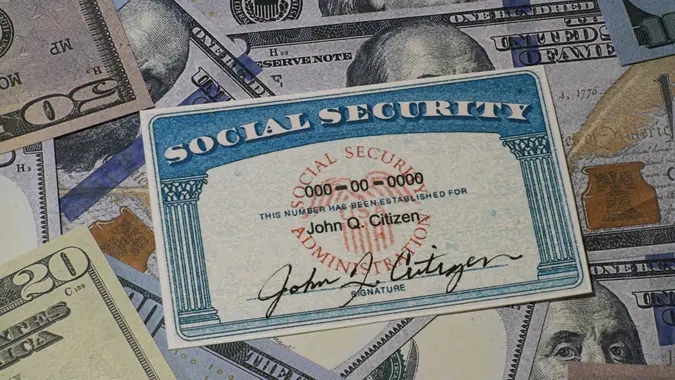Advertiser Disclosure
GOBankingRates works with many financial advertisers to showcase their products and services to our audiences. These brands compensate us to advertise their products in ads across our site. This compensation may impact how and where products appear on this site. We are not a comparison-tool and these offers do not represent all available deposit, investment, loan or credit products.
What Happened to Social Security Under Trump, Biden and 13 Other Presidents
 Written by
Andrew Lisa
Written by
Andrew Lisa
 Edited by
Cory Dudak
Edited by
Cory Dudak

Commitment to Our Readers
GOBankingRates' editorial team is committed to bringing you unbiased reviews and information. We use data-driven methodologies to evaluate financial products and services - our reviews and ratings are not influenced by advertisers. You can read more about our editorial guidelines and our products and services review methodology.

20 YearsHelping You Live Richer

Reviewed by Experts

Trusted by Millions of Readers
As people grow older and get closer to retirement age, their incomes decline and their healthcare expenses grow.
Before Social Security, indigence was a part of old age for millions of elderly Americans, who depended on their children, churches and charities to sustain themselves and meet their most basic needs.
That all changed 90 years ago with the Social Security Act, which created an insurance fund to provide a basic income for workers who had passed their earning years. Today, the program remains the bedrock of the social safety net, but it looks a whole lot different than it did in 1935.
Here’s how every president has impacted Social Security since the program was founded during the Great Depression.
Franklin Delano Roosevelt
The father of the social safety net, FDR signed the Social Security Bill into law on Aug. 14, 1935. He had called on Congress to craft a social insurance policy just 14 months before the bill became the Social Security Act. The first part of the act, a key component of the New Deal, gave aid to the states to distribute to their needy senior residents. The second part provided for a federal benefits program for retired workers.
For the first time in American history, most could count on something in their golden years besides their children or church.
At the height of the Great Depression, the act also provided unemployment insurance, which allowed the involuntarily jobless to retain part of their purchasing power. The act also created four programs to benefit vulnerable children and the blind, all funded by the federal government but run by the states.
Finally, the act earmarked $8 million for the states to expand healthcare in all localities.
Harry Truman
Fifteen years after FDR signed the Social Security Act into law, millions of elderly, infirm and destitute Americans were still excluded from Social Security and dependent on public charity. Harry Truman, who would become the first Medicare recipient under President Lyndon B. Johnson, expanded the program with the Social Security Act Amendments of 1950.
The amendments expanded the program to 10 million more people by including the non-farm unemployed, although certain occupations like doctors, engineers and lawyers were excluded. It also expanded the program to cover the Virgin Islands and Puerto Rico.
The act roughly doubled benefits payouts, increased payouts to widows and orphans and made qualifying easier.
Dwight D. Eisenhower
On Sept. 1, 1954, President Eisenhower dramatically expanded Social Security to include 10 million more Americans in the Old-Age and Survivors Insurance Program. The fund was opened to self-employed farmers and domestic employees, as well as other specific occupations.
The 1954 expansion also included a disability freeze provision that protected the benefits of the disabled and another that enhanced benefits by removing the lowest-earning years from the records of beneficiaries.
In 1960, Eisenhower expanded the program yet again to allow disabled workers of all ages and their dependents to collect benefits. The 1960 expansion also created a program known as Kerr-Mills, which provided medical care for elderly people who were not receiving government benefits but who couldn’t afford to provide care for themselves.
John F. Kennedy
In 1961, JFK amended Social Security to allow workers to opt for early retirement at age 62 — but only men. The amendments also increased the minimum monthly benefit and the minimum disability benefit. Benefit increases were extended to dependents and survivors as well.
The Kennedy revisions also made it easier to become eligible for the program. The new eligibility requirements brought 160,000 new applicants onto the rolls in the first year.
Lyndon B. Johnson
Thirty years after FDR created the program, Lyndon Johnson expanded Social Security more than any president since the program’s inception with the Social Security Act Amendments of 1965, known better as the Medicare and Medicaid Act.
The first provision created a federalized health insurance program for people 65 and older — before Medicare, only about half of the country’s seniors were covered by health insurance, and most coverage was minimal. The second provision created a health insurance program for people with limited income of any age. Medicaid was to be funded by state and federal sources and administered by the states.
Richard Nixon
In 2022, Social Security recipients got their biggest raise in 40 years when the SSA responded to rising inflation with the highest cost of living adjustment (COLA) since 1982. They have Richard Nixon to thank for the boost.
In 1972, Nixon signed a bill into law that provided a 20% across-the-board increase for monthly benefits. More important, the legislation he signed established the procedures for issuing automatic COLAs every year starting in 1975.
Gerald Ford
In 1975, President Ford enacted the Child Support Enforcement program, a federal/state initiative that made it much harder for non-custodial parents to avoid their financial responsibilities to their children. It was the most important part of the Social Service Amendments of 1974, which created part D of Title IV of the Social Security Act.
The measure gave the SSA the responsibility of tracking down parents who had deserted their children and allowed for the garnishment of wages — and Social Security benefits — to collect child support.
Jimmy Carter
By the late 1970s, Social Security was in dire financial straits and the program was on an unsustainable course.
To shore up the program’s long-term financial solvency, President Carter signed the Social Security Amendments of 1977. The amendments contained changes that Congress made to how benefits would be computed.
The changes generally lowered the amount that beneficiaries received. They also, however, raised taxes to increase future revenues.
Ronald Reagan
President Reagan initiated a massive overhaul of the program with the Social Security Amendments of 1983. The amendments authorized the taxation of Social Security recipients over a certain income level and increased tax rates on the self-employed to equal the employer/employee payroll contributions that fund Social Security.
The so-called “self-employment tax” is still in effect today.
Reagan’s signature raised the retirement age from 65 to 67 — albeit gradually over decades through 2027. The amendments also removed the last remaining gender-based provisions and increased benefits for disabled widows and widowers who become eligible before 60 years old.
George H.W. Bush
President Bush did not sign any major Social Security legislation during his only term in office. He was the only president who didn’t significantly change the program in the more than half-century that passed since its inception.
He did, however, enact several administrative laws. Some dealt with the way agencies exchanged information over their computer systems. Others dealt with things like safeguarding the privacy of beneficiaries.
Bill Clinton
President Clinton signed the Omnibus Budget Reconciliation Act of 1993, increasing the percentage of benefits that could be taxed for beneficiaries who earned higher incomes. When the income limits were established under Reagan, up to 50% of a recipient’s Social Security benefits could be taxed. The bill that President Clinton signed raised that threshold to 85%.
Three years later, in 1996, he signed the Contract With America Advancement Act. The legislation denied disability benefits to people whose disabilities were related to alcoholism and/or drug addiction.
George W. Bush
President George W. Bush oversaw the largest overhaul of Medicare in the program’s nearly 40-year history. Most significantly, the Medicare Prescription Drug, Improvement and Modernization Act (MMA) of 2003 amended Title XVIII (Medicare) of the Social Security Act to create Medicare Part D, the first prescription drug benefit in the program’s history.
The act also redesigned Medicare Part C, which is the managed care portion of the program. The legislation also changed the name of Part C from Medicare + Choice to Medicare Advantage.
Barack Obama
President Obama’s signature achievement was the Patient Protection and Affordable Care Act, known colloquially as Obamacare. The president signed the legislation into law on March 23, 2010.
The most significant impact that Obamacare had on Social Security was a reduction in the Medicare prescription drug plan subsidy for higher-income earners.
Donald Trump
President Trump’s greatest contribution to Social Security came in the wake of the COVID-19 pandemic. On March 27, 2020, he signed the Coronavirus Aid, Relief, and Economic Security Act — the CARES Act — into law.
The act impacted Social Security in several ways.
Two sections reduced FICA taxes owed by certain employers and delayed payment of FICA/SECA while ensuring the solvency of the Social Security Trust Funds. It also suspended the recovery of student loan debt from Social Security benefits.
Reelected in 2024, Trump says has no plans to touch Social Security, although he has said he doesn’t think seniors should be taxed on their benefits.
Joe Biden
For President Biden, it was the pandemic, once again, that steered early legislation. In this case it was the American Rescue Plan Act of 2021 that impacted Social Security.
Most of the provisions involving the SSA required the agency to provide personal information and confirm Social Security numbers for millions of stimulus recipients.
For fiscal year 2023, the Social Security Administration’s operating budget was increased to $14.1 billion from $13.34 billion the previous year. However, that was less than the $14.8 billion Biden requested.
In introducing his 2024 budget plan in March 2023, Biden said he wanted to make sure his administration was “protecting and strengthening” Social Security for Americans, and he reaffirmed his stance against cuts to Social Security or Medicare.
Share This Article:




You May Also Like

90% of Americans Plan To Skip This Social Security Advice -- and It Could Cost Them
December 16, 2025
9 min Read

How Many Hours Can You Work and Still Collect Social Security Benefits?
December 15, 2025
9 min Read

I'm Retired and Regret Not Claiming Social Security at 65 -- Here's Why
December 14, 2025
9 min Read




Social Security's Biggest Lie: Why 'Full Retirement Age' Isn't What You Think
December 11, 2025
9 min Read

Here's the Salary You Need To Make To Get the Maximum Social Security Benefit
December 11, 2025
9 min Read

Social Security Just Made a Major Change: Act Now To Protect Your Retirement
December 11, 2025
9 min Read

I Asked ChatGPT If Billionaires Should Even Get Social Security Checks -- Here's Its Take
December 12, 2025
9 min Read

Taylor Swift Turns 36: Here's What Her Social Security Check Might Look Like -- and How You Compare
December 12, 2025
9 min Read

How Much Is Donald Trump's Social Security Check -- And Is He Collecting It?
December 10, 2025
9 min Read



Make your money work for you
Get the latest news on investing, money, and more with our free newsletter.
By subscribing, you agree to our Terms of Use and Privacy Policy. Unsubscribe at any time.


Thanks!
You're now subscribed to our newsletter.
Check your inbox for more details.



Sending you timely financial stories that you can bank on.
Sign up for our daily newsletter for the latest financial news and trending topics.
For our full Privacy Policy, click here.
Looks like you're using an adblocker
Please disable your adblocker to enjoy the optimal web experience and access the quality content you appreciate from GOBankingRates.
- AdBlock / uBlock / Brave
- Click the ad blocker extension icon to the right of the address bar
- Disable on this site
- Refresh the page
- Firefox / Edge / DuckDuckGo
- Click on the icon to the left of the address bar
- Disable Tracking Protection
- Refresh the page
- Ghostery
- Click the blue ghost icon to the right of the address bar
- Disable Ad-Blocking, Anti-Tracking, and Never-Consent
- Refresh the page



